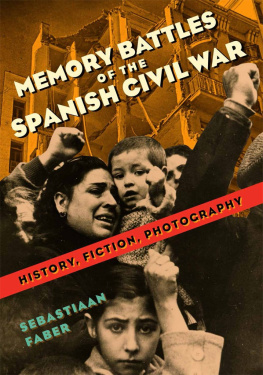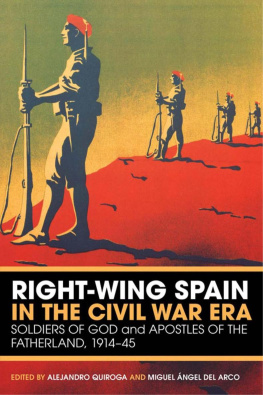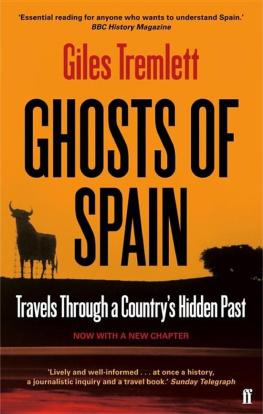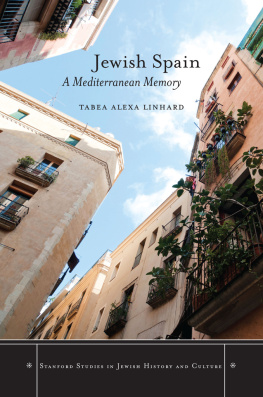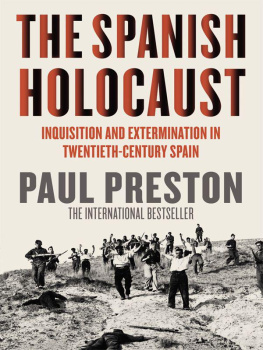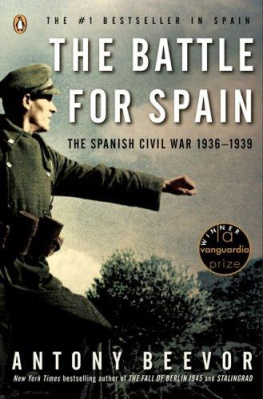2018 by Vanderbilt University Press
Nashville, Tennessee 37235
All rights reserved
First printing 2018
This book is printed on acid-free paper.
Manufactured in the United States of America
Library of Congress Cataloging-in-Publication Data
LC CONTROL NUMBER 2016058489
LC CLASSIFICATION NUMBER DP269.A56 F333 2017
DEWEY CLASSIFICATION NUMBER 946.081072
LC RECORD AVAILABLE AT lccn.loc.gov/2016058489
ISBN 978-0-8265-2178-1 (cloth)
ISBN 978-0-8265-2179-8 (paperback)
ISBN 978-0-8265-2180-4 (ebook)
ACKNOWLEDGMENTS
THIS BOOK WOULD NOT EXIST without the infinite generosity of the many friends and colleagues who, over the years, have been willing to listen and talk, read drafts, and make suggestions. Im afraid my debt to them is too large to repay. I owe the good qualities of this book to them. I would particularly like to thank Noelia Adnez, Palmar lvarez-Blanco, Montse Armengou, Manuel Aznar Soler, Mari Paz Balibrea, David Becerra, Kata Beilin, Peter N. Carroll, Almudena Carracedo, Francie Cate-Arries, Juan Carlos Cruz Surez, Simon Doubleday, Cecilia Enjuto-Rangel, Francisco Espinosa Maestre, Carolina Espinoza, James D. Fernndez, Francisco Ferrndiz, Teresa Frriz, Joseba Gabilondo, Pedro Garca-Caro, Pedro Garca Guirao, Sonia Garca Lpez, Marina Garde, Baltasar Garzn, Jorge Gaupp, Anthony Geist, Olga Glondys, Franois Godicheau, Antonio Gmez Lpez-Quiones, Jordi Gracia, Helen Graham, Gina Herrmann, Jess Izquierdo Martn, Gabriel Jackson, Ariel Jerez, David Jorge, Jo Labanyi, Germn Labrador, Susan Larson, Fernando Larraz, Jos Ramn Lpez, Miguel de Lucas, Ana Luengo, Steven Marsh, Mario Martn Gijn, Rebecca Haidt, Jordi Mar, Guillem Martnez, Marshall Mateer, Alberto Moreiras, Cristina Moreiras, Luis Moreno-Caballud, Carmen Moreno-Nuo, Gijs Mulder, Jos Mara Naharro-Caldern, Robert Newcomb, Fraser Ottanelli, Esther Pascua, Antonio Pedrs-Gascn, scar Pereira Zazo, Paul Preston, Joan Ramon Resina, Aaron Retish, Berta del Ro, Jacobo Rivero, Juan Rodrguez, Isis Sadek, Juan Salas, Benita Sampedro, Gervasio Snchez, Ignacio Snchez-Cuenca, Antoln Snchez Cuervo, Pablo Snchez Len, Ignacio Snchez-Prado, Yvonne Scholten, Bcquer Segun, Emilio Silva, Carles Sirera, Rosi Song, Steven Torres, Michael Ugarte, Isabelle Touton, Nol Valis, Jos del Valle, Jos Luis Villacaas, ngel Vias, William Viestenz, Flix Zamora, and Trisha Ziff, as well as Carlos Blanco Aguinaga (19262013) and Michael Ratner (19432016), who spent their lives fighting the good fight and are sorely missed. I would also like to thank my students at Oberlin College, as well as my colleagues Claire Solomon, Patrick OConnor, Ana Cara, Jed Deppman, Erik Inglis, Wendy Kozol, Geoff Pingree, Steven Volk, Kristina Mani, and deans Sean Decatur, Joyce Babyak, and Tim Elgren. I have been fortunate to enjoy the hospitality of Spanish editors willing to publish my rabble-rousing and sometimes experimental texts and podcasts: Alfonso Armada at FronteraD; the editorial team at Contratiempo; Magda Bandera at La Marea; and Miguel Mora at CTXT: Contexto y Accin.
I am grateful to Radboud University, particularly Brigitte Adriaensen, Maarten Steenmeijer, and dean Margot van Mulken for allowing me to spend six months in appeared in All donde uno dira que ya no puede haber nada, edited by Maarten Steenmeijer and Alexis Grohmann (Rodopi, 2009).
The staff at the International Institute for Social History and Leiden University were extremely helpful. Thanks, too, to the International Center of Photography, particularly Cynthia Young, for permission to reprint images by Robert Capa and Gerda Taro; to Ben Shneiderman and Helen Sarid, for permission to reprint images by David Seymour; to the International Institute for Social History in Amsterdam for permission to reproduce materials from its archive; and to John Heartfield and the Heartfield Community of Heirs for permission to reproduce a montage by John Heartfield. I deeply appreciate the expert support from Michael Ames, director of Vanderbilt University Press, and his staff, as well as Andrea Thorntons careful copyediting. My deepest thanks go to my family: Kim, Jakob, and Maya. I cant imagine life without them.
MEMORY BATTLES OF THE SPANISH CIVIL WAR
INTRODUCTION
Joining the Battle
Spanish History and Academic Engagement
AT A LIVE RADIO DEBATE on the day before the start of the campaign for the June 2016 elections, a sixteen-year-old Spaniard confronted a representative of the ruling Partido Popular (PP) with a provocative question. Do you feel proud, he asked, to belong to a party that has ignored the almost 100,000 people who are buried without their family members knowing where? The young man, who referred to mass graves from the Spanish Civil War that continue to litter the country eighty years later, went on to recall several dismissive comments about the victims and their families from prominent members of the PP. When he was done formulating his question, the audience erupted in a spontaneous ovation that lasted twenty seconds. Lets see, the PP representative, Ignacio Echniz, replied when the applause had died down. In 1975, we Spaniards worked very hard to close the wounds of the past... [and] to forget the past and work for the future.... The only thing we have said... is that we should not open up new political fronts that may fracture Spanish society because its very important to continue to work for the future so that our children and grandchildren... can have a country that lives in peace and liberty (Cadena Ser 2016). The reply was not surprising; Echniz spewed clichs that the Spanish Right, along with a portion of the Left, has been repeating for decades. What was surprising was the reaction from the audience: it scoffed. The ability to forget the past was long seen as a virtue in Spaineven a duty. But the common wisdom has shifted. The duty now is no longer to forget but to remember. Younger generations want to know what happened, who suffered, and who is to blame. And the means available to acquire and interpret this knowledge are not limited to history books. They include archeology, anthropology, sociology, and law, as well as film, photography, and fiction.
How have history, fiction, and photography shaped Spanish memory? How has democratic Spain dealt with the legacy of the Civil War, the Franco dictatorship, and the Transition? And how have academics, writers, filmmakers, photographers, and journalists in Spain and elsewhere engaged with a collective process that is central to the countrys future as a unified, functioning democracy? These are the three main questions that inform this book. They are also questions that have unleashed a spirited series of battles in the Spanish public sphere, particularly since the emergence around the year 2000 of what is often referred to as the memory movement or, rather more disparagingly, la moda de la memoria: the memory fad. The connotations this last word conjures upa trivial and passing obsessionare misplaced. In fact, Spains memory battles helped prepare the ground for the convulsive changes that have reshaped the countrys political landscape in the wake of the Great Recession, the 2011 rise of the indignados movement (known in Spain as el 15-M), and the creation of Podemos, a new political party, in 2014.
Between the late 1990s and Spains devastating economic crisis of 2009, the country witnessed the birth and rapid growth of a grassroots network of citizens associations that formulated a broad set of social and political demands. It called for the identification of thousands of mass graves dating from the Civil War, but it also demanded more attention to the rights of victims of right-wing repression since 1936 and a revision of the terms under which Spain transitioned to democracy after the death of Francisco Franco in 1975. Throughout the first decade of the twenty-first century, this grassroots phenomenon spawned a broad set of initiatives ranging from political rallies to volunteer-led exhumation projects, court cases, and formal appeals to the United Nations. In its wake rose a tidal wave of media productions about the Civil War and Francoism: novels, documentaries, history books, photography exhibits, feature films, soap operas, drama series, and thousands of articles in newspapers and magazines.

